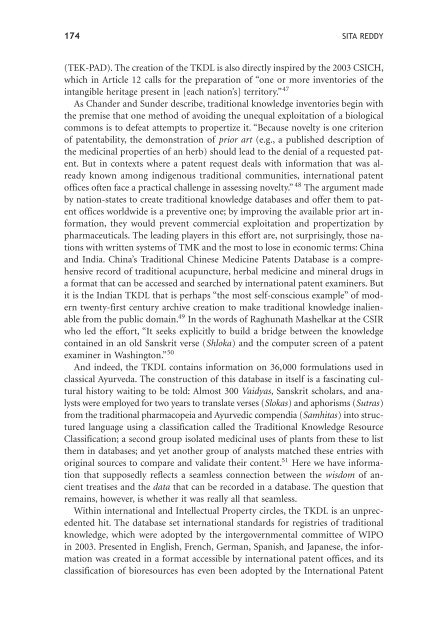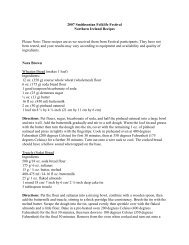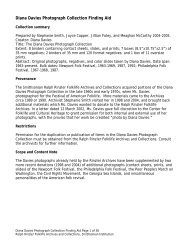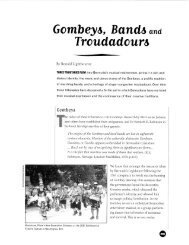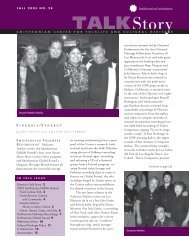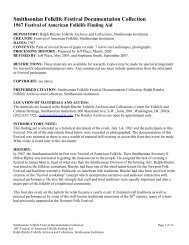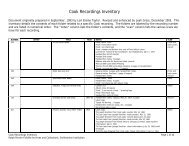Who Owns Traditional Medical Knowledge? - Smithsonian Center ...
Who Owns Traditional Medical Knowledge? - Smithsonian Center ...
Who Owns Traditional Medical Knowledge? - Smithsonian Center ...
You also want an ePaper? Increase the reach of your titles
YUMPU automatically turns print PDFs into web optimized ePapers that Google loves.
174 SITA REDDY<br />
(TEK-PAD). The creation of the TKDL is also directly inspired by the 2003 CSICH,<br />
which in Article 12 calls for the preparation of “one or more inventories of the<br />
intangible heritage present in [each nation’s] territory.” 47<br />
As Chander and Sunder describe, traditional knowledge inventories begin with<br />
the premise that one method of avoiding the unequal exploitation of a biological<br />
commons is to defeat attempts to propertize it. “Because novelty is one criterion<br />
of patentability, the demonstration of prior art (e.g., a published description of<br />
the medicinal properties of an herb) should lead to the denial of a requested patent.<br />
But in contexts where a patent request deals with information that was already<br />
known among indigenous traditional communities, international patent<br />
offices often face a practical challenge in assessing novelty.” 48 The argument made<br />
by nation-states to create traditional knowledge databases and offer them to patent<br />
offices worldwide is a preventive one; by improving the available prior art information,<br />
they would prevent commercial exploitation and propertization by<br />
pharmaceuticals. The leading players in this effort are, not surprisingly, those nations<br />
with written systems of TMK and the most to lose in economic terms: China<br />
and India. China’s <strong>Traditional</strong> Chinese Medicine Patents Database is a comprehensive<br />
record of traditional acupuncture, herbal medicine and mineral drugs in<br />
a format that can be accessed and searched by international patent examiners. But<br />
it is the Indian TKDL that is perhaps “the most self-conscious example” of modern<br />
twenty-first century archive creation to make traditional knowledge inalienable<br />
from the public domain. 49 In the words of Raghunath Mashelkar at the CSIR<br />
who led the effort, “It seeks explicitly to build a bridge between the knowledge<br />
contained in an old Sanskrit verse (Shloka) and the computer screen of a patent<br />
examiner in Washington.” 50<br />
And indeed, the TKDL contains information on 36,000 formulations used in<br />
classical Ayurveda. The construction of this database in itself is a fascinating cultural<br />
history waiting to be told: Almost 300 Vaidyas, Sanskrit scholars, and analysts<br />
were employed for two years to translate verses (Slokas) and aphorisms (Sutras)<br />
from the traditional pharmacopeia and Ayurvedic compendia (Samhitas) into structured<br />
language using a classification called the <strong>Traditional</strong> <strong>Knowledge</strong> Resource<br />
Classification; a second group isolated medicinal uses of plants from these to list<br />
them in databases; and yet another group of analysts matched these entries with<br />
original sources to compare and validate their content. 51 Here we have information<br />
that supposedly reflects a seamless connection between the wisdom of ancient<br />
treatises and the data that can be recorded in a database. The question that<br />
remains, however, is whether it was really all that seamless.<br />
Within international and Intellectual Property circles, the TKDL is an unprecedented<br />
hit. The database set international standards for registries of traditional<br />
knowledge, which were adopted by the intergovernmental committee of WIPO<br />
in 2003. Presented in English, French, German, Spanish, and Japanese, the information<br />
was created in a format accessible by international patent offices, and its<br />
classification of bioresources has even been adopted by the International Patent


